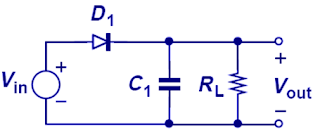The rectifier is circuit that convert AC voltage to DC voltage. The diode (D1) is the component playing at main roll. In rectifier, there always have capacitor (C1) as filter, to reduce the output voltage ripple.
The C1 called as Reservoir capacitor (Smoothing Capacitor).
Below is the input voltage and output voltage for the circuit. The output contain some voltage ripple, where the voltage ripple can reduce by increase the C1 capacitance.
Simulation at below shown the effect of C1 value.
The 10uf capacitor have low voltage ripple compare to 1uf, but,the I(D2) also increasing. The current is instantly increase (like pulse) with very high amplitude, it may causing the diode overload.
What is optimize value for C1 to provide the lowest voltage ripple and prevent diode over heat.
The analysis will start from capacitor (C1).
Step 1
Formula 1: (draft calculation)

Base on the circuit, the current flow from source and current flow to load is equal.
i = I input = I diode = I load = I charge capacitor = I discharge from capacitor (in DC form)
C = capacitance
dV = The delta voltage, in this case, the voltage ripple is the level use to calculate.
dt = the charging capacitor time.
half wave rectifier = 1/(input signal frequency)
full wave rectifier = 1/(input signal frequency x 2)
Assuming, the design target parameter
max output current to load = 150mA
Vpeak = (Vrms x 1.414) = Vac meter measure x 1.414 = 21.21V x 1.414 = 30Vpeak
Rload = 21V/150mA = 140ohm
dV = 10% of ripple voltage = 30 x 10% = 3V
The AC signal frequency = 50Hz, haft wave rectifier.
dt = 1/50 = 0.02s
Cmin = (150mA x 0.02s) / 3V
= 1000uf
Formula 2: (accurate calculation)
C = minimum capacitance
Vp = Vpeak
f = signal frequency
[note] f = half wave rectifier
2f = full wave rectifier
R = Load resistance
Vr = Vripple
result :-
Cmin = 1428uf
The other formula for calculate the voltage ripple, but it only able apply to ripple voltage not exceed 10%
Step 2
Calculate the maximum diode current. There have 2 maximum diode current need to know.
The power supply start-up maximum current and maximum operating current.
In power supply start-up stage, the reservoir capacitor (C1) is in full discharge stage.
We may turn on the transient voltage on Vpeak, there will huge current flow throw diode to charge the capacitor, we cannot very clearly using the formula to calculate inrush current into diode, but, we can limit the current.
The Rinrush (R1) connect at before capacitor and output of rectifier circuit. It limit the maximum current flow across the diode.
Vp(on) = Vpeak. the circuit may turn on at voltage peak level.
Vdiode = voltage drop on diode (forward voltage of diode)
IFSM = the diode non-repetitive peak forward current.
the maximum inrush current limit that affordable by diode.
When charging capacitor (C1) there will have pulse current flow through the D1, that is maximum operating current.
Vp = Vpeak
T = 1/frequency
dt = the diode conduction time, where the pulse current appear.
2 = half wave rectifier
4 = full wave rectifier
dt = ((1/50) / (2 x 3.142)) x ((2 x 3) / 30) ^ 0.5
= 1.4233ms
maximum operating current:-
Ipeak = (T x Idc ) / dt
T = 1/frequency
dt = diode conduction time
Idc = average load current
Ipeak = peak current through the rectifier
Ipeak = (1/50 x 150mA) / 1.4233ms
= 2.108A
or
design safety = 1.4 x 2.108 = 3A
For design safety, the diode IFRM (repetitive peak forward current) must around 3A.
reference:
http://proton.ucting.udg.mx/materias/CIE-24/Unidad.02/cktosDiodos.pdf
http://whites.sdsmt.edu/classes/ee320/notes/320Lecture8.pdf
http://electrapk.com/surge-current-in-capacitor-input-filter/
http://waynestegall.com/audio/ripple.htm
http://www.zen22142.zen.co.uk/Design/dcpsu.htm










I would like to find full wave diode rectifier
ReplyDelete